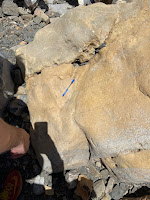NizamPur Field Visit - Geology
Nizampur Field Trip - Geology
University of Peshawar
 |
| NizamPur Geology Field Visit - Rashid Khan Afridi |
Geology Field Visit - The Untold Stories of Rocks
Field visits are a crucial component of geology instruction. They are essential in assisting students learn about, comprehend, and appreciate the many geological formations and aspects. The primary goal of the visit was to introduce the students to the various rock types, geological features and structures, and lithologies.Geology Of Nizampur Basin
Geology Field Trip to Nizampur - The Story
Geological Structure of Nizampur
Our first field trip where the emphasis was mainly on structure geology was this one. The Attock Cherat Range lies to the south, and the Kala Chitta Range is to the north, of the Nizampur Basin. The Indus River borders it on its east, and the footwall of the Hisartang fault is where the Attock Cherat and Kala Chitta Range meet.
The Eocene-aged Margilla Hill Limestone is the youngest rock unit found in the Nizampur Basin, and the Jurassic-aged Samana Suk formation is the oldest rock unit exposed there.
The sequence is normal from younger to older rocks until the Kawagarh Formation, after which it returns to normal until the Lumshiwal Formation as it moves north from the Margilla Hill Limestone in the Kahi Valley area. The Samana Suk formation is repeated, which indicates the presence of a subsurface fault.
Synclines, anticlines, conjugate fractures, folds, and other structural geology features were also seen.Additionally, we learned how to use a Silva compass to gauge a bed's quantity and direction of dip.
In this
field trip we
studied the syncline
within the Margalla
Hill limestone, on top
of the Patala
shales. We observed conjugate
fractures, folded strata,
and thrust faults
within Nizampur Basin.










Geology is love 🖤
ReplyDeleteGreat job
ReplyDelete